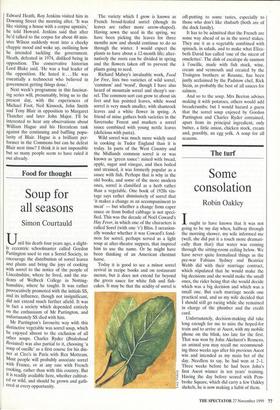Food for thought
Soup for all seasons
Simon Courtauld
Mr Partington's favourite way with this distinctive vegetable was sorrel soup, which he enjoyed almost to the exclusion of all other soups. Charles Ryder (Brideshead Revisited) was also partial to it, choosing 'a soup of oseille' as a first course for his din- ner at Ciro's in Paris with Rex Mottram. Most people will probably associate sorrel With France, or at any rate with French cooking, rather than with this country, But it is readily available here, whether cultivat- ed or wild, and should be grown and gath- ered at every opportunity. The variety which I grow is known as French broad-leafed sorrel (though its leaves are rather more arrow-shaped). Having sown the seed in the spring, we have been picking the leaves for three months now and should continue to do so through the winter. I would expect the plants to have about a 12-month life; alter- natively the roots can be divided in spring and the flowers taken off to prevent the plants going to seed.
Richard Mabey's invaluable work, Food for Free, lists two varieties of wild sorrel, 'common' and 'wood', though I have also heard of mountain sorrel and sheep's sor- rel. The common sort can grow to about six feet and has pointed leaves, while wood sorrel is very much smaller, with shamrock leaves and a white flower in spring. A friend of mine gathers both varieties in the Savernake Forest and markets a sorrel sauce combined with young nettle leaves (delicious with pasta).
Wild sorrel was much more widely used in cooking in Tudor England than it is today. In parts of the West Country and the Midlands common sorrel is or was known as 'green sauce': mixed with bread, apple, sugar and vinegar, and then boiled and strained, it was formerly popular as a sauce with fish. Perhaps that is why in the old books, and some of the more modern ones, sorrel is classified as a herb rather than a vegetable. One book of 1920s vin- tage says rather dismissively of sorrel that 'it makes a change as an accompaniment to meat' — but whether a change from caper sauce or from boiled cabbage is not speci- fied. This was the decade of Noel Coward's Hay Fever, in which one of the characters is called Sorel (with one 'r') Bliss. I occasion- ally wonder whether it was Coward's fond- ness for sorrel, perhaps served as a light soup at after-theatre suppers, that inspired him to use the name. Or he might have been thinking of an American chestnut horse.
Today it is good to see a minor sorrel revival in recipe books and on restaurant menus, but it does not extend far beyond the green sauce for white fish and fish- cakes. It may be that the acidity of sorrel is off-putting to some tastes, especially to those who don't like rhubarb (both are of the dock family).
It has to be admitted that the French are some way ahead of us in the sorrel stakes. They use it as a vegetable combined with spinach, in salads, and to make what Eliza- beth David has called 'one of the nicest of omelettes'. The dish of escalope de saumon l'oseille, made with fish stock, wine, cream and vermouth and created by the Troisgros brothers at Roanne, has been justly acclaimed by the Padstow chef, Rick Stein, as probably the best of all sauces for salmon.
And so to the soup. Mrs Beeton advises making it with potatoes, others would add breadcrumbs; but I would hazard a guess that the sorrel soup enjoyed by Gordon Partington and Charles Ryder contained, apart from its principal ingredient, only butter, a little onion, chicken stock, cream and, possibly, an egg yolk. A soup for all seasons.


























































































 Previous page
Previous page